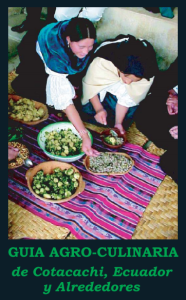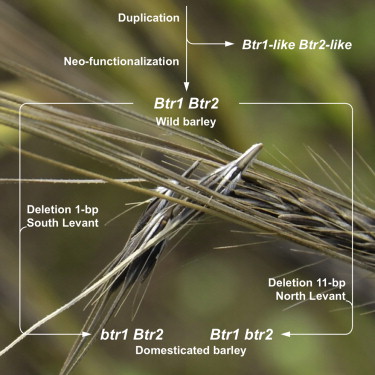- Why aren’t there more crops among the orchids?
- This pepper is not so much a crop as a weapon of mass destruction.
- Now here’s a crop. New tomato has taste, storability, looks. But I think it’s dating.
- Maize with cool amino acids reaches Ethiopia. Must have walked there.
- Really old squash seeds.
- Cary Fowler on the Weather Channel. You heard me.
- Quakers have an opinion on the right to food and climate change. Well, why shouldn’t they? They also have a UN office, but that’s another story. No word on whether they made the Weather Channel.
- Ok, so apparently the answer is data. Says a data company. And open data at that. Quakers nonplussed.
- Botanizing in N or S America? There’s an app for that.
- The rise and rise of gin. And I certainly need one.
Brainfood: Apple diversity, Wheat diversity, Wild lettuce diversity, Picking cores, Saudi rice diversity, Indian minor millets, Species distribution modelling, Pollinator diversity
- Chloroplast heterogeneity and historical admixture within the genus Malus. Three genetic networks within the genus, with the cultivated species in one of them.
- Subgenomic Diversity Patterns Caused by Directional Selection in Bread Wheat Gene Pools. Five subpopulations, dividing the European from the Chinese material. Some parts of the genome more in need of diversity than others.
- Biodiversity of Lactuca aculeata germplasm assessed by SSR and AFLP markers, and resistance variation to Bremia lactucae. Some race-specific resistance in the wild relative in Israel-Jordan, but nothing extraordinarily efficient.
- Using Multi-Objective Artificial Immune Systems to Find Core Collections Based on Molecular Markers. Very fancy math not only picks populations to maximise diversity, but also potentially at the same time minimises distance from the office.
- Assessment of ISSR based molecular genetic diversity of Hassawi rice in Saudi Arabia. It’s not just one thing.
- Minor Millets as a Central Element for Sustainably Enhanced Incomes, Empowerment, and Nutrition in Rural India. Holistic mainstreaming pays dividends.
- Minimum required number of specimen records to develop accurate species distribution models. Depends on prevalance, but 15 is a good rule of thumb.
- Microsatellite Analysis of Museum Specimens Reveals Historical Differences in Genetic Diversity between Declining and More Stable Bombus Species. Species which declined less diverse than species which did not.
Tourism and conservation
The Convention on Biological Diversity has just published its User’s Manual on the CBD Guidelines on Biodiversity and Tourism Development. It seems very thorough, as far as it goes — but does it go far enough? In particular, what about tourism offers based on agricultural biodiversity? This is what the guide says about how tourism could help achieve the Aichi Targets:
It has been shown that effective tourism planning and actions can contribute to achieving at least 12 of the 20 Aichi Biodiversity Targets contained in the [Strategic Plan for Biodiversity 2011-2020]. For some Targets (5, 8, 9, 10 and 12) this is primarily about greater control and management to reduce damage to biodiversity from tourism. For others (1, 11, 15, 18, and 20) this is about pursuing the positive contribution of tourism to biodiversity awareness, protected areas, habitat restoration, community engagement, and resource mobilization. A further dimension is the better integration of biodiversity and sustainability into development policies and business models that include tourism, thereby supporting Aichi Targets 2 and 4.
But what about Target 13? Remember that?
By 2020, the genetic diversity of cultivated plants and farmed and domesticated animals and of wild relatives, including other socio-economically as well as culturally valuable species, is maintained, and strategies have been developed and implemented for minimizing genetic erosion and safeguarding their genetic diversity.
 Surely agritourism is potentially just as valuable a tool for conserving biodiversity as trekking in protected areas. Shouldn’t the user’s manual, and indeed the guidelines, address the needs of this sector, or at least recognize that it exists? It seems that the CBD has trouble thinking of agricultural landscapes as harbouring biodiversity worthy of being conserved — and visited.
Surely agritourism is potentially just as valuable a tool for conserving biodiversity as trekking in protected areas. Shouldn’t the user’s manual, and indeed the guidelines, address the needs of this sector, or at least recognize that it exists? It seems that the CBD has trouble thinking of agricultural landscapes as harbouring biodiversity worthy of being conserved — and visited.
Nibbles: Conservation genetics, African fish farming, Ecological intensification, Elderly diets, Organic breeding, Conference tweeting, Mexican maguey, African PBR
- Conservation genetics papers from Latin America, courtesy of special issue of the Journal of Heredity. No ag, but no problem.
- African aquaculture takes off. Or perhaps rises to the surface would be more appropriate.
- Expert parses what experts said “sustainable intensification” means.
- Leafy greens and wine good for oldies. Good to know.
- Student Organic Seed Symposium to discuss “Growing the Organic Seed Spectrum: A Community Approach” in a few days’ time.
- How to tweet. At scientific conferences, that is.
- Maguey genebank in the offing. Well worth tweeting about.
- Arusha Protocol on the Protection of New Plant Varieties (Plant Breeders’ Rights) adopted. Basically UPOV 1999 for Africa. But I suspect the polemics are only just starting.
Brittle rachis in barley, in one diagram
 Oh gosh, I’m really liking this graphical abstract idea. But would it have killed them to have a map in the background?
Oh gosh, I’m really liking this graphical abstract idea. But would it have killed them to have a map in the background?